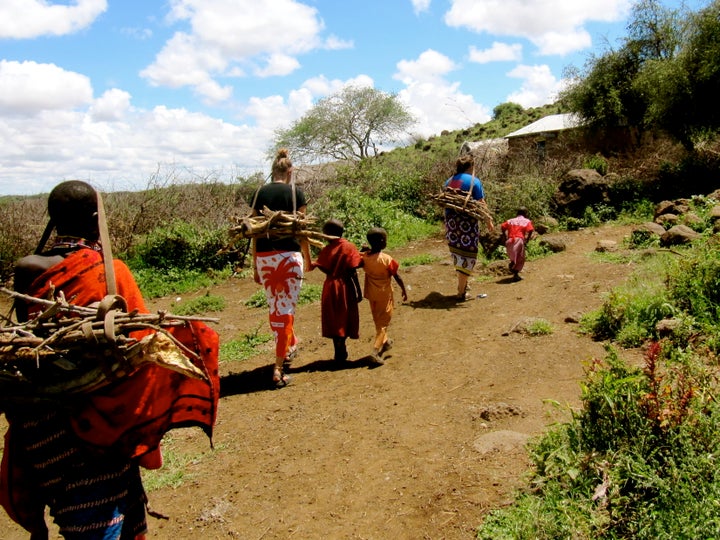
Students learn to carry firewood on St. Lawrence University’s Kenya Semester Program
For decades the demographics and business of American higher education has become increasing more global. As the Trump administration rolls out their foreign policy and higher-education agendas, there are clear signals that this upward trend in global engagement is in jeopardy.
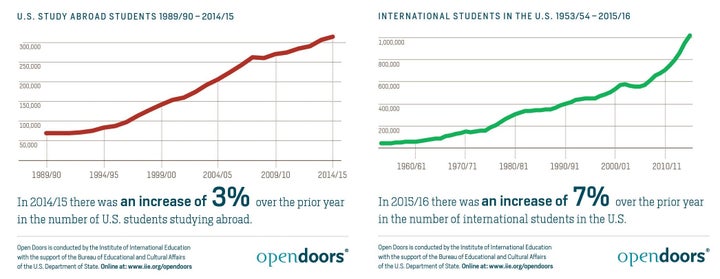
According to the Institute of International Education’s (IIE) annual Open Doors Report, in 2015-2016 more than 1 million international students were enrolled in U.S. colleges and universities, injecting over 32 billion dollars into the U.S. economy and supporting 400,000 U.S. jobs. The most recent data also shows that U.S. institutions sent more than 300,000 American students outside the country to “study abroad” in 183 nations and territories, including Antarctica.
Trump’s “America First” vision of global engagement endangers future growth in international education and the thousands of American jobs this industry supports.
The January 27th executive order temporarily banning travel and migration from seven majority Muslim nations in the Middle East and Africa has sent shock waves through American higher education. Universities are scrambling to determine how their students and employees may be impacted, as challenges to the executive order make their way through the federal court systems. Many official statements have condemned President Trump’s action while also warning students and university employees potentially impacted to cancel travel plans, and remain in the country.
According to the lasted IIE data, the executive order directly impacts more than 17,300 students and at least 2,300 visiting scholars from these nations, who can no longer travel out of the country for fear of not being able to return to finish their studies and/or work. A study by College Factual noted that the loss of revenue from students from these seven countries alone, could cost the U.S. economy up to 700 million$ annually.
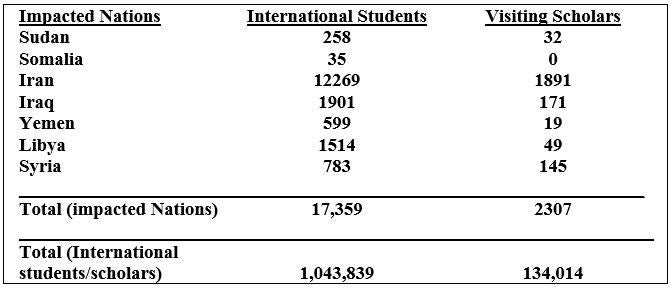
What is still unclear is the how this ban may impact U.S. permanent residents and those with dual citizenship linked to countries listed in the ban. IIE statistics do not collect data on dual “U.S. citizens, immigrants (permanent residents, or I-151 or “Green Card” holders), refugees, undocumented immigrants (illegal aliens), students with deferred action status or anyone on a B visa" as “international.” Consequently, the real impact of future “extreme vetting” policies may extend to thousands of additional students and employees at American institutions.
This latest action is part of a growing isolationist trend in Trump’s foreign policy. As international education advocates such as Bradley Feuling have argued since November, “Donald Trump’s election has raised uncertainty and doubts about a reversal of globalization, as well as concerns about a continued commitment to diversity.”
Trump’s recent actions are not a complete break from the recent past, and reflect a worrying trend in divestment from key parts of the developing world. As the new staff of the Department’s of State and Education take over key programs which help fund and direct higher education, what does the historic data on global engagement tell us about the current state of international education?
Deciphering the Data on International Education
The “big data” of steadily increasing student migration is often packaged as a grand celebration of the globalization of U.S. higher education. However demographic trends prior to the 2016 presidential election point to a growing disconnect between domestic calls for greater diversity and programming on campus and the priorities of U.S. investment in curriculum abroad. While American institutions talk increasingly about the need for “global learning,” in reality, international recruitment focuses heavily on Asia and study abroad programs on encountering the world through western-Europe.

As the numbers of U.S. students studying abroad passed 313,000 annually, Europe remains a dominant and growing site of U.S. student engagement abroad. The latest report indicates that recent European growth outpaced declining numbers in South America and Asia, with Sub-Saharan Africa showing the largest drop in overall participation in 2014/15.
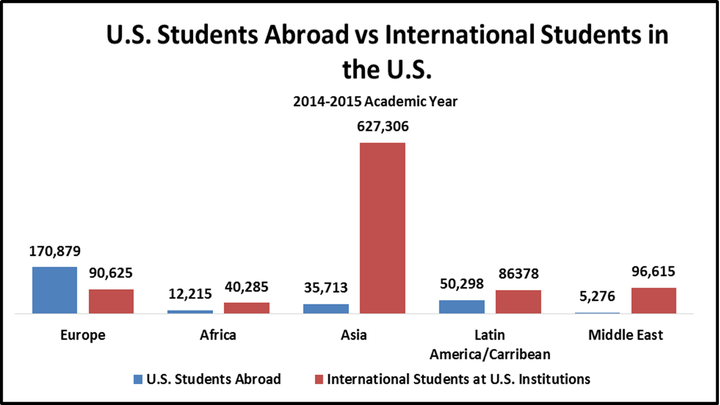
Open Doors Report 2016 (figures for Oceania and Canada not included)
American students participating in study abroad are predominantly women (66%), overwhelmingly white (73%) and disproportionately represented by the nation’s elite private universities. While the numbers suggest some positive gains for U.S. students of color over the past decade, the geography, demography and curricular focus also shows trends in U.S. disengagement with much of the “non-western” world.
So what do the trends of privileging Asian diversity at home and Eurocentric learning abroad tell us about the U.S. international education the Trump administration inherits?
As a specialist in African history teaching at an institution with a long standing study abroad program in Kenya, the nearly 20% decline in U.S. students studying in Sub-Saharan Africa offers a particularly troubling example of short sighted and reactionary policies. Much of the developing world is viewed through a broad geography of constant “crisis,” where risk outweighs the reward of intercultural engagement.
Where’s Africa? Demographics and Disconnects in the Developing World
The world’s second largest continent has been a marginal site for U.S. study abroad programs for decades and dominated by the opportunity to study contemporary “problems” refracted through western fears and values. Popular American visions of Africa are still dominated by the colonial mentality of the “dark continent” where it is up to the “white savior” to lift up African society.
Through a “single story” of poverty, conflict or disease, African affairs are often magnified against a backdrop of majestic flora and fauna. This is a trope which drives down student engagement with the continent and pushes programs to market stereotypes as the main entry points, even when the ultimate goal is to challenge them. A simple search of “study abroad in Africa” reveals dozens of programs focused wildlife conversation, public health, development studies and service learning packaged as “voluntourism.”
By viewing Africa through a lens of “crisis,” sweeping misconceptions of risk have shaped demographics and curricula in reactionary ways. The U.S. response to the 2014-2015 Ebola outbreak in West Africa offers a cautionary tale in just how vulnerable international education is to the politics of fear associated with African discourse in the U.S.
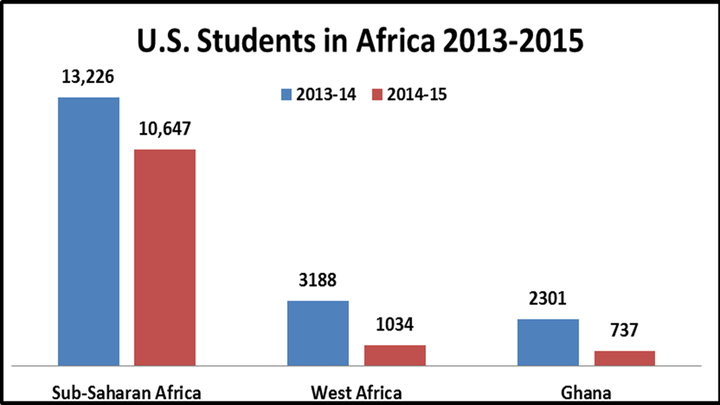
Beginning in March of 2014, an Ebola outbreak in Guinea became a public health disaster in West Africa with wide reaching consequence. As the virus spread from Guinea to neighboring Sierra Leone and Liberia, the World Health Organization reports that through 2015, more than 28,000 people were infected and over 11,000 lost their lives in these three small West African nations. Outside of these three countries, the U.S. Centers for Disease Control and Prevention (CDC) reports that there were fewer than 40 confirmed cases. 28 of these were in Nigeria, Mali, and Senegal, and 7 were in the U.S, U.K., Spain and Italy.
Stoked by media coverage of the crisis as an African wide epidemic, the localized public health crisis in the three small West African nations had a drastic impact on international education. For instance even before he was a Presidential candidate, Donald Trump sent early signals of his reactionary style in dealing with global crisis and engagement with Africa.
Comments like this were widespread and had disastrous effects on study abroad programs in Sub-Saharan Africa. As tourists cancelled trips across the continent, Universities responded by suspending travel to West Africa in large numbers.
In Senegal, where there was only one reported case of Ebola and the WHO declared the country “Ebola Free” by October, U.S. study abroad numbers dropped by 47.8% in 2014-2015. In Ghana, the most popular destination for U.S. study abroad programs in West Africa, saw a 68% drop in student arrivals, even without a single confirmed case of Ebola in the country.
Even popular media criticism mocking global ignorance of African geography could not curtail the impact on international travel.
Negotiating both the perception and reality of risk has become a full time job for many advocates of study abroad in Africa. Even as outlets like the Washington Post pushed back on the biased coverage of Ebola as an African wide pandemic, study abroad professionals had to constantly remind prospective students and families for instance, that London and Paris were geographically closer to the outbreak than Nairobi or Cape Town.
While promoting student safety is a top priority for any university, the 67% drop in U.S. study abroad students traveling to West Africa reflects a reactionary approach to engagement with much of the developing world. In comparison, when terrorist attacks in 2004 and 2005 hit the Madrid and London public transportation networks, U.S. institutions did not respond with the same approach. Even though these two deadly attacks left nearly 3,000 casualties in their wake, U.S. study abroad statistics reveal that student arrivals in Spain and the U.K. continued to increase.
International Education in Trump’s America
The U.S. response to the Ebola outbreak offers a cautionary tale for international education under the new administration. Donald Trump’s past comments about the world’s second largest continent have been couched in Birther critiques of Obama’s Kenyan heritage, calls to divest in foreign assistance and tweets portraying African nations a rife with disease, corruption and crime. This vision of Africa promotes dated stereotypes, but fits with Trump’s fear mongering statements on Islam and isolationist signals about U.S. global engagement.
Just two weeks into Trump administration, a flurry of executive orders and policy statements have left international education professionals scrambling to come up with a strategy for recruiting students and promoting essential global engagement on and off-campus.
The evidence though is clear. Any threat to international education in U.S. would have disastrous effects on an industry which supports 100,000s of American jobs and helps train the next generation of teachers, diplomats, soldiers, and countless other professionals with essential tools in intercultural understanding. There is no question these skills are essential for current and future generations to compete in the global economy and approach international relations with empathetic knowledge and experience.
Matt Carotenuto is Associate Professor of History and Coordinator of African Studies at St. Lawrence University in Canton NY. At St. Lawrence he works closely with the University’s long-standing Kenya Semester Program. With Katherine Luongo he is the author of Obama and Kenya: Contested Histories and the Politics of Belonging in Kenya. His work on African affairs and study abroad has also been featured in Politico, Salon, Open Democracy, Africa is A Country and the Washington Post.
